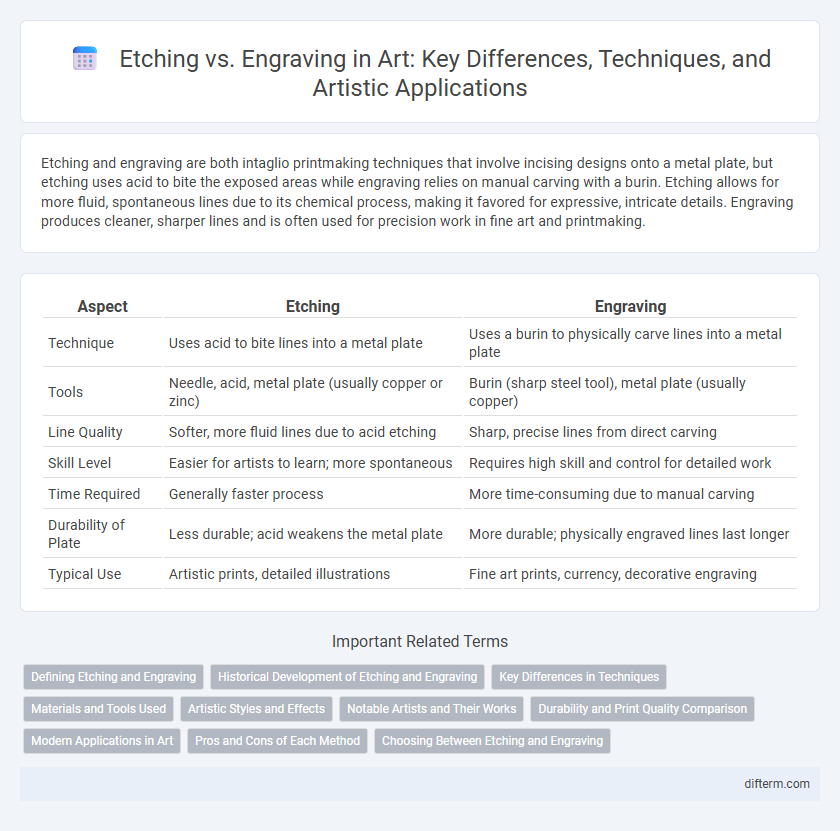Etching and engraving are both intaglio printmaking techniques that involve incising designs onto a metal plate, but etching uses acid to bite the exposed areas while engraving relies on manual carving with a burin. Etching allows for more fluid, spontaneous lines due to its chemical process, making it favored for expressive, intricate details. Engraving produces cleaner, sharper lines and is often used for precision work in fine art and printmaking.
Table of Comparison
| Aspect | Etching | Engraving |
|---|---|---|
| Technique | Uses acid to bite lines into a metal plate | Uses a burin to physically carve lines into a metal plate |
| Tools | Needle, acid, metal plate (usually copper or zinc) | Burin (sharp steel tool), metal plate (usually copper) |
| Line Quality | Softer, more fluid lines due to acid etching | Sharp, precise lines from direct carving |
| Skill Level | Easier for artists to learn; more spontaneous | Requires high skill and control for detailed work |
| Time Required | Generally faster process | More time-consuming due to manual carving |
| Durability of Plate | Less durable; acid weakens the metal plate | More durable; physically engraved lines last longer |
| Typical Use | Artistic prints, detailed illustrations | Fine art prints, currency, decorative engraving |
Defining Etching and Engraving
Etching involves using acid to carve designs into a metal plate coated with a protective ground, enabling artists to create intricate and detailed imagery through controlled chemical processes. Engraving employs a sharp tool called a burin to manually incise lines directly into a metal surface, producing precise and clean marks favored for fine lines and detailed textures. Both techniques are fundamental intaglio printmaking methods but differ significantly in their tools and execution, influencing the final artistic effect.
Historical Development of Etching and Engraving
Etching and engraving both emerged as prominent printmaking techniques during the Renaissance, with engraving dating back to the 15th century and etching gaining popularity in the early 16th century. Engraving involves incising designs directly into metal plates with a burin, while etching uses acid to create lines by corroding exposed metal areas coated with a protective ground. The historical development of etching allowed for greater artistic freedom and quicker processes, influencing the evolution of printmaking and the dissemination of fine art in Europe.
Key Differences in Techniques
Etching involves using acid to bite into a metal plate where the protective ground has been removed by a needle, creating lines that hold ink for printing. Engraving requires physically carving into the metal surface with a burin, resulting in precise and clean lines without chemical processes. The depth and texture in engraving are controlled manually, while etching offers more fluid and spontaneous line work due to the acid's biting action.
Materials and Tools Used
Etching employs acid-resistant grounds on metal plates, typically copper or zinc, with needles or styluses to create designs that acid then etches into the surface. Engraving uses harder tools like burins to carve directly into metal plates such as copper, steel, or sometimes wood, allowing for precise and intricate lines. Both rely on metal plates but differ significantly in the use of chemicals for etching versus manual incision for engraving.
Artistic Styles and Effects
Etching allows for fluid, expressive lines and rich tonal variations achieved by acid biting, making it ideal for delicate shading and atmospheric effects. Engraving produces crisp, precise lines through physical incision, resulting in bold contrasts and detailed textures favored in intricate patterns and graphic clarity. Both techniques shape distinct artistic styles, with etching lending softness and spontaneity while engraving emphasizes sharpness and control.
Notable Artists and Their Works
Albrecht Durer is renowned for his masterful etchings, such as "Melencolia I," which showcase detailed line work and expressive textures. In engraving, artists like Marcantonio Raimondi elevated the medium with precise, clean lines seen in works like "The Judgement of Paris." These techniques shaped the evolution of printmaking, influencing generations through their distinctive approaches to image creation.
Durability and Print Quality Comparison
Etching uses acid to create designs on a metal plate, resulting in softer lines that produce rich, varied tones but wear down faster during printing. Engraving involves physically incising the design with sharp tools, producing sharp, precise lines that yield higher durability and consistent print quality over longer print runs. The engraved plates' resistance to wear makes them ideal for detailed, high-volume art prints requiring sustained sharpness and clarity.
Modern Applications in Art
Etching and engraving remain pivotal techniques in modern art, each offering unique textural qualities and line precision that contemporary artists exploit for diverse visual effects. Digital tools have expanded etching's accessibility, allowing artists to merge traditional acid-based processes with digital printing for innovative multimedia works. Engraving maintains its relevance in fine art prints and metalwork, where laser technology enhances detail control and production efficiency, pushing boundaries in artistic expression.
Pros and Cons of Each Method
Etching offers artists greater freedom with fluid lines and softer textures, achieved by using acid to bite into a metal plate, but it requires careful timing to avoid over-etching and lacks the precision of engraving. Engraving produces sharp, clean lines with high detail by physically cutting into the plate with a burin, providing durability and consistency, though it demands significant skill and time-intensive effort. Both methods excel in printmaking; etching suits expressive, spontaneous work while engraving favors intricate, controlled designs.
Choosing Between Etching and Engraving
Choosing between etching and engraving depends on the desired level of detail and artistic style. Etching uses acid to create softer, more varied lines suited for expressive, textured images, while engraving involves physically cutting into the plate for precise, clean lines and sharp details. Artists often prefer etching for its fluidity and engraving for its durability and fine control in printmaking.
etching vs engraving Infographic

 difterm.com
difterm.com